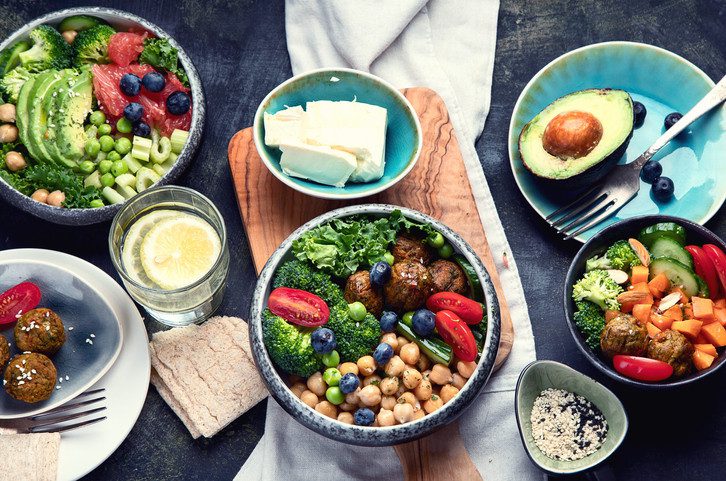If you have a family history of heart disease, you probably try to stick to a healthy diet to reduce your heart risk. But did you know that focusing on combinations of foods vetted for their disease-fighting ability can help lower risks for many chronic illnesses, including cancer, diabetes, and cardiovascular disease that can lead to heart attacks and strokes?
The Alternative Healthy Eating Index (AHEI) assigns ratings to foods and nutrients predictive of chronic disease. Harvard T.H. Chan School of Public Health researchers created the AHEI as an alternative to the US Department of Agriculture’s Healthy Eating Index, which measures adherence to the federal Dietary Guidelines for Americans.
“The Healthy Eating Index and the Alternative Healthy Eating Index are similar, but the AHEI is more oriented toward reducing the risk of chronic disease,” says Natalie McCormick, a research fellow in medicine at Harvard Medical School.
Rating your diet
The AHEI grades your diet, assigning a score ranging from 0 (nonadherence) to 110 (perfect adherence), based on how often you eat certain foods, both healthy and unhealthy fare.
For example, someone who reports eating no daily vegetables would score a zero, while someone who ate five or more servings a day would earn a 10. For an unhealthy option, such as sugar-sweetened drinks or fruit juice, scoring is reversed: a person who eats one or more servings would score a zero, and zero servings would earn a 10.
Research links high scores on the AHEI with a lower risk of chronic disease. One key study reported in the Journal of Nutrition, which included 71,495 women and 41,029 men, found that people who scored higher on the AHEI had a 19% lower risk of chronic disease, including a 31% lower risk of coronary heart disease and a 33% lower risk of diabetes, when compared to people with low AHEI scores. Another study in the American Journal of Clinical Nutrition found that among 7,319 participants, those who got high scores on the AHEI had a 25% lower risk of dying from any cause, and more than a 40% lower risk of dying from cardiovascular disease, than the low AHEI scorers.
Separate research on older men and older women has shown that those who score highest on the AHEI perform better on activities like climbing stairs, lifting groceries, walking a mile, and engaging in moderate or vigorous activities than those who score lowest.
A global study noted wide variations among nations in diet quality, and predicted that improving current diets could prevent millions of deaths from cancer, coronary artery disease, stroke, respiratory diseases, kidney disease, diabetes, and digestive diseases.
Can you use the AHEI to score your own diet?
It’s probably not practical to use the actual AHEI scoring system, says Kathy McManus, director of the department of nutrition at Harvard-affiliated Brigham and Women’s Hospital. But you can easily incorporate more of the healthy AHEI foods into your diet.
Some top choices include the following:
- Vegetables. Aim for five a day, and focus on squeezing in extra servings of green leafy vegetables, which may help reduce the risk of diabetes. Try to skip the potatoes and fries.
- Fruit. Try to eat four servings a day, an amount that might help protect against cardiovascular disease and some cancers. Avoid fruit juice, because drinking too much might actually increase your risk of diabetes.
- Whole grains. Eating five to six servings a day might help head off cardiovascular disease, diabetes, and colorectal cancer, says McManus. Minimize refined grains, which are associated with a higher risk of diabetes, heart disease, and potentially other chronic diseases.
- Nuts, legumes, and vegetable protein (tofu). Getting a serving a day of protein from these sources is a healthy way to add nutrients to your diet, and might help protect against diabetes and cardiovascular disease.
- Fish. Adding fish to your weekly meal plan can give your body a dose of healthy fatty acids, which could help reduce your risk of cardiovascular disease and potentially diabetes.
- Healthy fats. Adding healthy unsaturated fats to your diet helps reduce your risk of heart disease and diabetes. Some good options are olive oil, canola oil, peanut oil, or safflower oil, says McManus. These healthy fats are particularly beneficial if you are swapping them for saturated fats, such as butter.
Also look to the MyPlate tool for guidance (available in multiple languages). It’s based on much of the same research that experts used to develop the AHEI. Adding more of these chronic disease-fighting foods into your diet can help keep you in good health over the long term.
Source by www.health.harvard.edu


